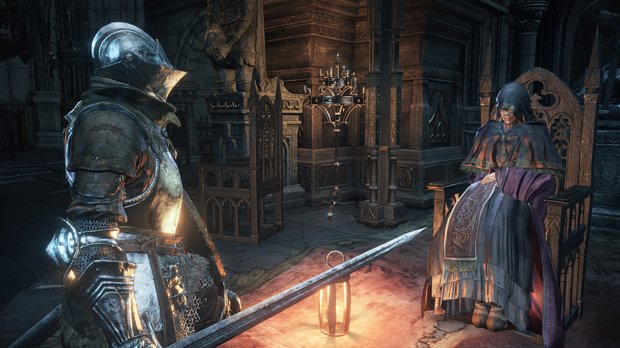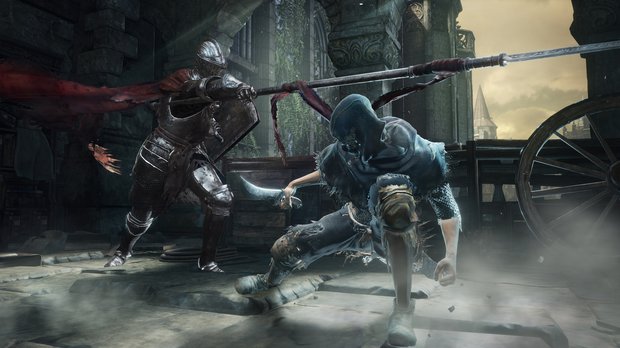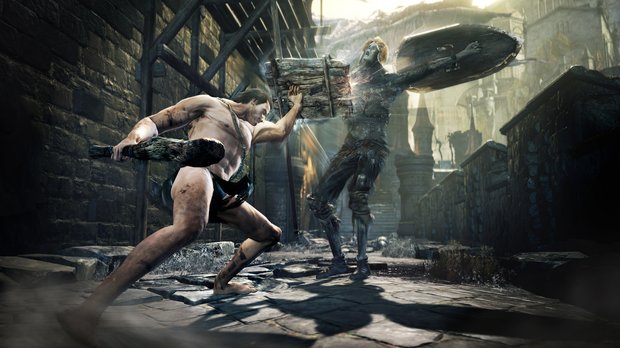Dark Souls 3 is a rapid-fire love letter to the whole series (and Bloodborne)
Shortly after Dark Souls 3’s surprise announcement at E3 2015, original game Director Hidetaka Miyazaki clarified that while it would not be the last game in the series per se, it would be the last of the traditional Souls games before the series moved on in a new direction.
In hindsight, having now played through DS3’s first five hours and opening three sections – and bosses – Miyazaki needn’t have been so explicit in his explanation. In the same way the Dark Souls games themselves relate their lore, systems, and overall meaning quietly, through practical exploration and ambient narrative texture, so too does Dark Souls 3’s design disseminate the truth of the situation without the need for words. From the beginning of the demo to the very end, this feels like a final summation of Miyazaki’s RPG work, every key conceit and evolution - from Demon’s Souls to Bloodborne - noted, accounted for, and paid tribute to. It is, in effect, a greatest-hits time capsule, condensing an eight-year period of a studio’s work, and preserving it as a hybrid snapshot.
It all starts out traditionally enough. An ominous cutscene about the impending end of the world, the death of fire, and the rise of several titanic, once-dead powers who are most certainly the game’s main bosses. Then the player character rises from their own grave – you’re Unkindled this time, rather than Hollow, though the differences are unclear – and it’s on to the character creation screen as normal.
Except that it’s not. You see this time, Dark Souls’ previously arbitrary starting class options matter a great deal more, the pre-set builds feeling immediately far more effective with their weapons, gear and skills. I, for example, go for the Pyromancer, who has a decent one-handed axe, a mid-sized shield, and the ability to hurl around a dozen significantly damaging fireballs, powered by a Demon’s Souls-style magic bar rather than Dark’s usual ‘charges’. But there are set-ups that cover every major specialisation in the series, from the magical focus of the mage to the fast-but-weak archetype of the dual-wielding thief.

Some might understandably balk at the free gifting of Dark Souls’ advanced-game builds from the off – the first game, for example, encourages dozens of hours’ investigation, discovery and exploration in order to expand, craft, and master your character – but DS3 feels like a game with slightly different priorities. It knows that long-time players have walked this journey before, and seems eager to deliver them more quickly to where they know they’re going. And for new players, this ‘best of Dark Souls’ angle will, for better or worse, drop them straight into the meatier, more versatile mid-level game, lessening the confusion and tentative character growth of the early hours.
It’s a theme that continues once I discover the Firelink Shrine, following an early, largely linear romp through the opening section and first training boss. Archetypal big-knight-with-slow-but-heavy sweeping attack vanquished, I find DS3’s version of the central safe zone rather better equipped than usual. In fact it’s a bountiful hybrid of Demon’s Souls’ Nexus hub and Bloodborne’s Hunters’ Dream.
Set within an unusually large and opulent temple, DS3’s key levelling and resting area is tended by a rather talkative new Firekeeper, a hybrid of Demon's Souls Maiden in Black and Bloodborne’s Doll in all but name. But I’m also surprised to find the first Dark Souls’ blacksmith, Andre – or an identical descendant/ancestor – alongside a well-stocked merchant and one or two other familiar NPCs, ready and waiting to accommodate me. Again, Dark Souls is (in some cases literally) pushing its goods up front, providing immediate access to the path of weapon and armour upgrades – I find the required materials scattered around rather liberally, too – and support items, where once they would have been teased out across the game’s first act. The items and systems are still resolutely Dark Souls, but their presentation is clearly inspired by the streamlined delivery of Miyazaki’s more dynamic Lovecraftian horror.
Weekly digests, tales from the communities you love, and more

As for the various things I do with those weapons and abilities, Dark Souls 3 takes a step back toward the more traditional when I hit the first main area, the Wall of Lodeleth. A largely outdoor section set on and around a castle rampart, its tight, modular design and perfectly judged enemy placement immediately trigger the series’ classic, paranoid, oppressive-but-fair combat dynamic. Every path, tower and rooftop is crafted with From’s now utterly honed instinct for building deceptively dangerous spaces.
It’s still amazing how one or two of the right enemies in the right place can suddenly fill an area that once felt open and breezy. It’s still exhilarating as space seems to expand and contract with the ever-shifting back-and-forth of an evolving duel. Every kill is still a major victory, every loss entirely fair and deserved, however painful. And every enemy bigger than the standard grunt remains a figure of absolute, thought-halting horror. Dark Souls’ focus, precision, and pacing are still that on-point.
Not that the combat model has remained static. While the solid fundamentals of spacing, defence, parries and block-stuns underpin everything with the same fighting-game purity, the pace has ramped up. It’s not that Dark Souls 3 is strictly faster, more that a multitude of small tweaks make it feel that way through an overall increase in dynamism. It’s testament to the robustness of the series’ original design that it can take such bending while still feeling authentic.

Raising my shield now barely slows me down at all – though the stamina penalty remains - making rapid attack and retreat a little safer. Evasive rolls and steps activate more quickly, launching me in and out of the fray with greater immediacy. The stun suffered by weaker enemies when I block their strikes seems more pronounced, allowing me to retaliate with greater abandon. Things haven’t been made easier though. My attackers are more aggressive too, and more liable to take quicker initiative to harshly punish any mistake I make. My ability to be more aggressive is certainly a useful weapon, but the rashness it encourages is also a quintessentially Miyazaki trap.
These lessons learned for good and ill, alongside the virtue of patience taught by DS3’s more mobile, patrolling mobs (those giant knights can wait until I have a more reliable solution than sneaking past when their backs are turned), I take down the boss and move on to the next area. And that’s when things really change.
Arriving at a rural Undead village on the outskirts of the castle – pleasingly ferried there by Anor Londo’s harpies, one of many shout-outs to the original Dark Souls – I am presented with a very different environment. A far more open, organic, flowing environment, made up of a great many sprawling, eminently explorable, non-linear routes to the next bonfire. Wherever in Solaire’s name that might be. You see, so large and winding is the village, and so smartly laid out in terms of twisting terrain and line of sight, that it takes a while before I even work out which direction is forward. And every ‘wrong’ path is as risky as it is potentially rewarding.

But it’s not just the style of layout that shifts radically here. This is the point at which I really come to understand the malleability of Dark Souls 3’s remodelled combat. With the nippier grunts of the Wall long gone, replaced by taller, slower villagers of more fluid movement and greater range – pro-tip: Don’t get into a duel against a pitchfork – all-out aggression rapidly becomes the correct course. Those faster rolls allow me to hurl myself into attacks before my foes (who now feel like prey rather than hunters) can take the initiative. And it works. They are warm butter, and I am a meat cleaver. The entire dynamic changes in a moment, and suddenly… Look, I’m not going to beat around the bush any longer: most of us probably know where this is going. At this point, Dark Souls 3 turns into Bloodborne 2. There’s no ambiguity about it.
As my play-style changes, the game makes more admissions. Forgetting that I even have a shield, ferocity and motion are my tools, and the latter reveals hitherto hidden offensive capability. It turns out that I can stagger certain enemies by rolling directly into them, giving me an impromptu stun move not a million miles away from the function of Bloodborne’s pistol shot. It’s a strange feeling, recognising one game’s flow in another’s mechanics, but there’s no doubt that this is Bloodborne’s gameplay as channelled through Dark Souls’ systems.

The feeling only increases as I explore further. A large bonfire distracts a huge swathe of enemies. I quietly work my way around the outside, strategically aggroing my quarry of choice using my ranged pyro attack exactly like Bloodborne’s pebble lure. I even nail a few with exploding barrels. And as I investigate the village’s various nooks and crannies, I find a plethora of new and varied weapons scattered around, from bigger, better axes, to bespoke blades, to magical implements and a whip. Enemies still drop gear, but the really interesting stuff comes from environmental discovery.
Again, it seems that DS3 may be taking a cue from Miyazaki’s last game, weapon collecting taking up the philosophy of ‘explore and you will find’, rather than Souls’ usual emphasis on rare random drops and unique weapon upgrade paths. A clearer route to more options, certainly, and definitely a move that echoes the rest of the game’s front-and-centre remix of its traditional facets. But at this point I find myself wondering just how coherent the final game is going to be. It’s definitely fun, and undeniably compelling, but it very much remains to be seen whether its various ideas will coalesce into a complete Dark Souls game, or simply an engaging megamix of disparate tones and identities.



